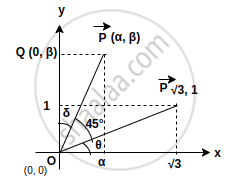Advertisements
Advertisements
प्रश्न
Let a vector `αhati + βhatj` be obtained by rotating the vector `sqrt(3)hati + hatj` by an angle 45° about the origin in counter-clockwise direction in the first quadrant. Then the area of triangle having vertices (α, β), (0, β) and (0, 0) is equal to ______.
विकल्प
1
`1/2`
`1/sqrt(2)`
`2sqrt(2)`
उत्तर
Let a vector `αhati + βhatj` be obtained by rotating the vector `sqrt(3)hati + hatj` by an angle 45° about the origin in counter-clockwise direction in the first quadrant. Then the area of triangle having vertices (α, β), (0, β) and (0, 0) is equal to `underlinebb(1/2)`.
Explanation:

Let `vecP = sqrt(3)hati + hatj`
⇒ tanθ = `(1/sqrt(3))`
⇒ θ = 30°
`vecp^' = αhati + βhatj`
θ + 45° + δ = 90°
⇒ δ = 45° – 30°
δ = 15°
Now, Area of ΔOP'Q
= `1/2(OP^' cos15^circ) xx (OP^' sin15^circ)`
= `1/4(2sin15^circ cos15^circ)(OP^')^2`
= `1/4(sin30^circ)(OP^')^2`
= `1/4(1/2)(sqrt((3)^2 + 1^2)) = 1/2` ...[∵ OP = OP']
